Changjian Li
SMooGPT: Stylized Motion Generation using Large Language Models
Sep 04, 2025Abstract:Stylized motion generation is actively studied in computer graphics, especially benefiting from the rapid advances in diffusion models. The goal of this task is to produce a novel motion respecting both the motion content and the desired motion style, e.g., ``walking in a loop like a Monkey''. Existing research attempts to address this problem via motion style transfer or conditional motion generation. They typically embed the motion style into a latent space and guide the motion implicitly in a latent space as well. Despite the progress, their methods suffer from low interpretability and control, limited generalization to new styles, and fail to produce motions other than ``walking'' due to the strong bias in the public stylization dataset. In this paper, we propose to solve the stylized motion generation problem from a new perspective of reasoning-composition-generation, based on our observations: i) human motion can often be effectively described using natural language in a body-part centric manner, ii) LLMs exhibit a strong ability to understand and reason about human motion, and iii) human motion has an inherently compositional nature, facilitating the new motion content or style generation via effective recomposing. We thus propose utilizing body-part text space as an intermediate representation, and present SMooGPT, a fine-tuned LLM, acting as a reasoner, composer, and generator when generating the desired stylized motion. Our method executes in the body-part text space with much higher interpretability, enabling fine-grained motion control, effectively resolving potential conflicts between motion content and style, and generalizes well to new styles thanks to the open-vocabulary ability of LLMs. Comprehensive experiments and evaluations, and a user perceptual study, demonstrate the effectiveness of our approach, especially under the pure text-driven stylized motion generation.
Sketch2Anim: Towards Transferring Sketch Storyboards into 3D Animation
Apr 27, 2025Abstract:Storyboarding is widely used for creating 3D animations. Animators use the 2D sketches in storyboards as references to craft the desired 3D animations through a trial-and-error process. The traditional approach requires exceptional expertise and is both labor-intensive and time-consuming. Consequently, there is a high demand for automated methods that can directly translate 2D storyboard sketches into 3D animations. This task is under-explored to date and inspired by the significant advancements of motion diffusion models, we propose to address it from the perspective of conditional motion synthesis. We thus present Sketch2Anim, composed of two key modules for sketch constraint understanding and motion generation. Specifically, due to the large domain gap between the 2D sketch and 3D motion, instead of directly conditioning on 2D inputs, we design a 3D conditional motion generator that simultaneously leverages 3D keyposes, joint trajectories, and action words, to achieve precise and fine-grained motion control. Then, we invent a neural mapper dedicated to aligning user-provided 2D sketches with their corresponding 3D keyposes and trajectories in a shared embedding space, enabling, for the first time, direct 2D control of motion generation. Our approach successfully transfers storyboards into high-quality 3D motions and inherently supports direct 3D animation editing, thanks to the flexibility of our multi-conditional motion generator. Comprehensive experiments and evaluations, and a user perceptual study demonstrate the effectiveness of our approach.
PoseTraj: Pose-Aware Trajectory Control in Video Diffusion
Mar 20, 2025



Abstract:Recent advancements in trajectory-guided video generation have achieved notable progress. However, existing models still face challenges in generating object motions with potentially changing 6D poses under wide-range rotations, due to limited 3D understanding. To address this problem, we introduce PoseTraj, a pose-aware video dragging model for generating 3D-aligned motion from 2D trajectories. Our method adopts a novel two-stage pose-aware pretraining framework, improving 3D understanding across diverse trajectories. Specifically, we propose a large-scale synthetic dataset PoseTraj-10K, containing 10k videos of objects following rotational trajectories, and enhance the model perception of object pose changes by incorporating 3D bounding boxes as intermediate supervision signals. Following this, we fine-tune the trajectory-controlling module on real-world videos, applying an additional camera-disentanglement module to further refine motion accuracy. Experiments on various benchmark datasets demonstrate that our method not only excels in 3D pose-aligned dragging for rotational trajectories but also outperforms existing baselines in trajectory accuracy and video quality.
CrossSDF: 3D Reconstruction of Thin Structures From Cross-Sections
Dec 05, 2024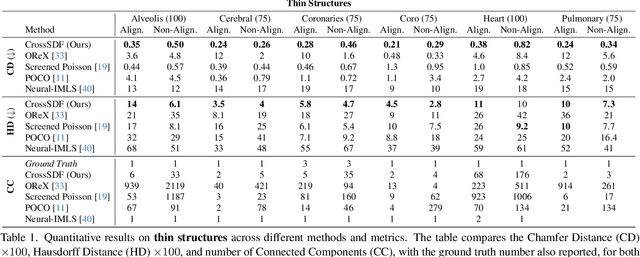
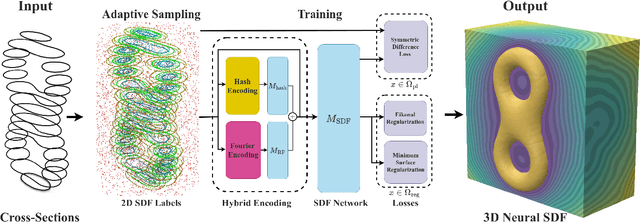

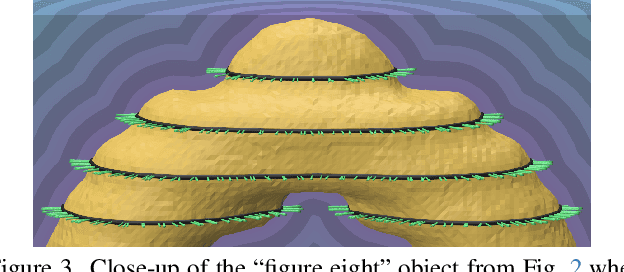
Abstract:Reconstructing complex structures from planar cross-sections is a challenging problem, with wide-reaching applications in medical imaging, manufacturing, and topography. Out-of-the-box point cloud reconstruction methods can often fail due to the data sparsity between slicing planes, while current bespoke methods struggle to reconstruct thin geometric structures and preserve topological continuity. This is important for medical applications where thin vessel structures are present in CT and MRI scans. This paper introduces \method, a novel approach for extracting a 3D signed distance field from 2D signed distances generated from planar contours. Our approach makes the training of neural SDFs contour-aware by using losses designed for the case where geometry is known within 2D slices. Our results demonstrate a significant improvement over existing methods, effectively reconstructing thin structures and producing accurate 3D models without the interpolation artifacts or over-smoothing of prior approaches.
PCDreamer: Point Cloud Completion Through Multi-view Diffusion Priors
Nov 28, 2024



Abstract:This paper presents PCDreamer, a novel method for point cloud completion. Traditional methods typically extract features from partial point clouds to predict missing regions, but the large solution space often leads to unsatisfactory results. More recent approaches have started to use images as extra guidance, effectively improving performance, but obtaining paired data of images and partial point clouds is challenging in practice. To overcome these limitations, we harness the relatively view-consistent multi-view diffusion priors within large models, to generate novel views of the desired shape. The resulting image set encodes both global and local shape cues, which is especially beneficial for shape completion. To fully exploit the priors, we have designed a shape fusion module for producing an initial complete shape from multi-modality input (\ie, images and point clouds), and a follow-up shape consolidation module to obtain the final complete shape by discarding unreliable points introduced by the inconsistency from diffusion priors. Extensive experimental results demonstrate our superior performance, especially in recovering fine details.
DepthCues: Evaluating Monocular Depth Perception in Large Vision Models
Nov 26, 2024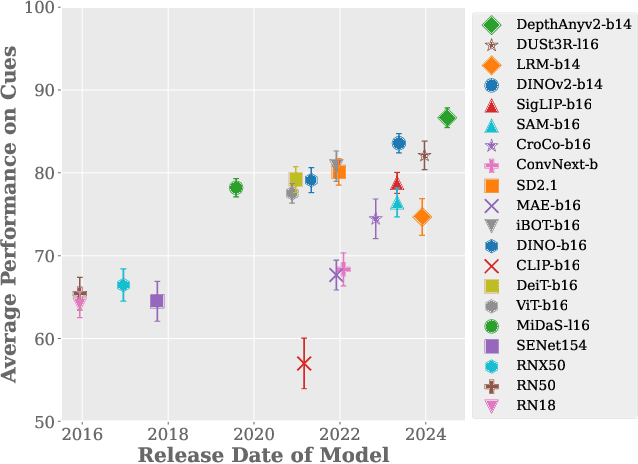
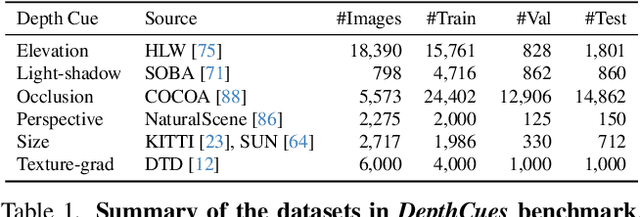

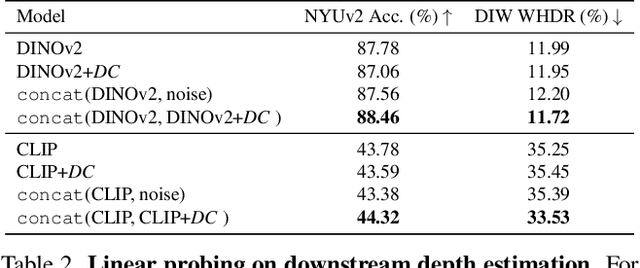
Abstract:Large-scale pre-trained vision models are becoming increasingly prevalent, offering expressive and generalizable visual representations that benefit various downstream tasks. Recent studies on the emergent properties of these models have revealed their high-level geometric understanding, in particular in the context of depth perception. However, it remains unclear how depth perception arises in these models without explicit depth supervision provided during pre-training. To investigate this, we examine whether the monocular depth cues, similar to those used by the human visual system, emerge in these models. We introduce a new benchmark, DepthCues, designed to evaluate depth cue understanding, and present findings across 20 diverse and representative pre-trained vision models. Our analysis shows that human-like depth cues emerge in more recent larger models. We also explore enhancing depth perception in large vision models by fine-tuning on DepthCues, and find that even without dense depth supervision, this improves depth estimation. To support further research, our benchmark and evaluation code will be made publicly available for studying depth perception in vision models.
VQ-SGen: A Vector Quantized Stroke Representation for Sketch Generation
Nov 25, 2024Abstract:This paper presents VQ-SGen, a novel algorithm for high-quality sketch generation. Recent approaches have often framed the task as pixel-based generation either as a whole or part-by-part, neglecting the intrinsic and contextual relationships among individual strokes, such as the shape and spatial positioning of both proximal and distant strokes. To overcome these limitations, we propose treating each stroke within a sketch as an entity and introducing a vector-quantized (VQ) stroke representation for fine-grained sketch generation. Our method follows a two-stage framework - in the first stage, we decouple each stroke's shape and location information to ensure the VQ representation prioritizes stroke shape learning. In the second stage, we feed the precise and compact representation into an auto-decoding Transformer to incorporate stroke semantics, positions, and shapes into the generation process. By utilizing tokenized stroke representation, our approach generates strokes with high fidelity and facilitates novel applications, such as conditional generation and semantic-aware stroke editing. Comprehensive experiments demonstrate our method surpasses existing state-of-the-art techniques, underscoring its effectiveness. The code and model will be made publicly available upon publication.
SpecSAR-Former: A Lightweight Transformer-based Network for Global LULC Mapping Using Integrated Sentinel-1 and Sentinel-2
Oct 04, 2024



Abstract:Recent approaches in remote sensing have increasingly focused on multimodal data, driven by the growing availability of diverse earth observation datasets. Integrating complementary information from different modalities has shown substantial potential in enhancing semantic understanding. However, existing global multimodal datasets often lack the inclusion of Synthetic Aperture Radar (SAR) data, which excels at capturing texture and structural details. SAR, as a complementary perspective to other modalities, facilitates the utilization of spatial information for global land use and land cover (LULC). To address this gap, we introduce the Dynamic World+ dataset, expanding the current authoritative multispectral dataset, Dynamic World, with aligned SAR data. Additionally, to facilitate the combination of multispectral and SAR data, we propose a lightweight transformer architecture termed SpecSAR-Former. It incorporates two innovative modules, Dual Modal Enhancement Module (DMEM) and Mutual Modal Aggregation Module (MMAM), designed to exploit cross-information between the two modalities in a split-fusion manner. These modules enhance the model's ability to integrate spectral and spatial information, thereby improving the overall performance of global LULC semantic segmentation. Furthermore, we adopt an imbalanced parameter allocation strategy that assigns parameters to different modalities based on their importance and information density. Extensive experiments demonstrate that our network outperforms existing transformer and CNN-based models, achieving a mean Intersection over Union (mIoU) of 59.58%, an Overall Accuracy (OA) of 79.48%, and an F1 Score of 71.68% with only 26.70M parameters. The code will be available at https://github.com/Reagan1311/LULC_segmentation.
DiffCSG: Differentiable CSG via Rasterization
Sep 02, 2024Abstract:Differentiable rendering is a key ingredient for inverse rendering and machine learning, as it allows to optimize scene parameters (shape, materials, lighting) to best fit target images. Differentiable rendering requires that each scene parameter relates to pixel values through differentiable operations. While 3D mesh rendering algorithms have been implemented in a differentiable way, these algorithms do not directly extend to Constructive-Solid-Geometry (CSG), a popular parametric representation of shapes, because the underlying boolean operations are typically performed with complex black-box mesh-processing libraries. We present an algorithm, DiffCSG, to render CSG models in a differentiable manner. Our algorithm builds upon CSG rasterization, which displays the result of boolean operations between primitives without explicitly computing the resulting mesh and, as such, bypasses black-box mesh processing. We describe how to implement CSG rasterization within a differentiable rendering pipeline, taking special care to apply antialiasing along primitive intersections to obtain gradients in such critical areas. Our algorithm is simple and fast, can be easily incorporated into modern machine learning setups, and enables a range of applications for computer-aided design, including direct and image-based editing of CSG primitives. Code and data: https://yyyyyhc.github.io/DiffCSG/.
Odd-One-Out: Anomaly Detection by Comparing with Neighbors
Jun 28, 2024



Abstract:This paper introduces a novel anomaly detection (AD) problem that focuses on identifying `odd-looking' objects relative to the other instances within a scene. Unlike the traditional AD benchmarks, in our setting, anomalies in this context are scene-specific, defined by the regular instances that make up the majority. Since object instances are often partly visible from a single viewpoint, our setting provides multiple views of each scene as input. To provide a testbed for future research in this task, we introduce two benchmarks, ToysAD-8K and PartsAD-15K. We propose a novel method that generates 3D object-centric representations for each instance and detects the anomalous ones through a cross-examination between the instances. We rigorously analyze our method quantitatively and qualitatively in the presented benchmarks.
 Add to Chrome
Add to Chrome Add to Firefox
Add to Firefox Add to Edge
Add to Edge